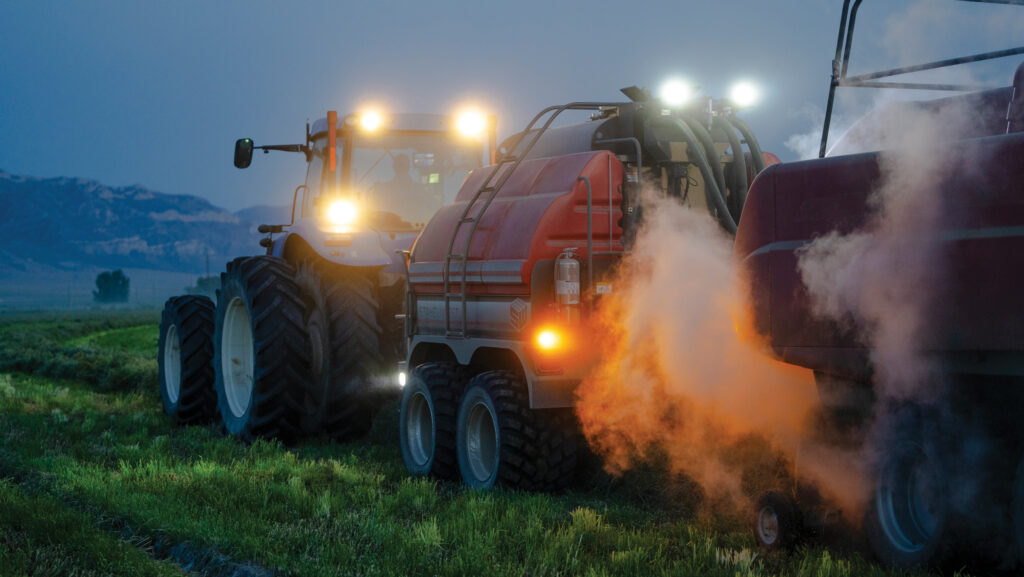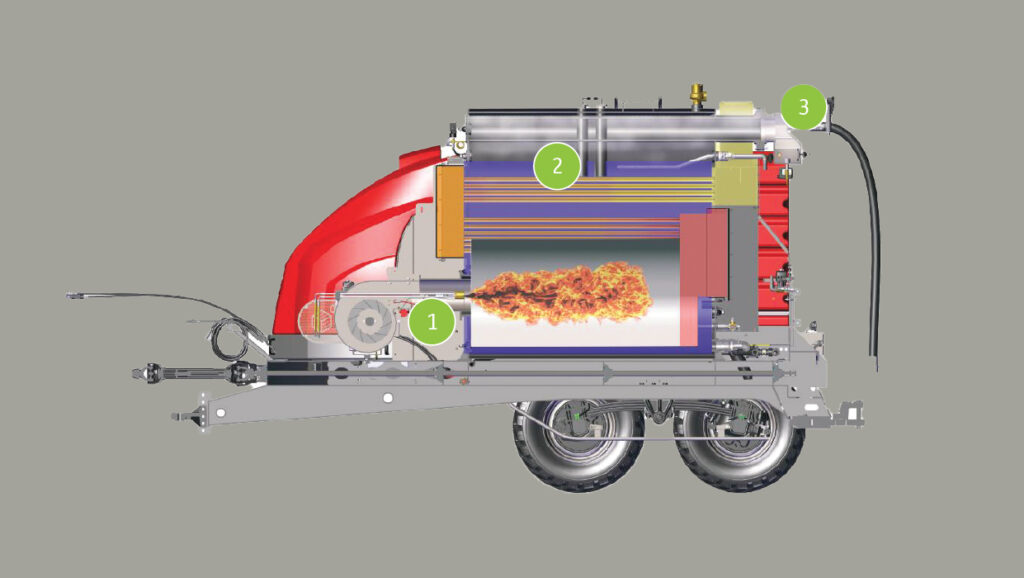Novel Staheli West baler attachment adds moisture to dry hay
 © Staheli West
© Staheli West With a prolonged hiss and machines briefly shrouded in vapour, a US commercial hay grower’s baling outfit is ready to get to work.
Conditions may not be ideal; it’s a very hot day, the wilted alfalfa is dry and consequently is vulnerable to costly leaf loss.
But with the ability to increase the crop’s moisture content on the move, there’s no need to hold off baling until a night-time dew improves the situation.
See more: Dutch dairy saves time with powered silage clamp cover rollers
The steam-generating DewPoint, trailed between the tractor and baler, provides that reassuring moisture, which is injected from above and below into the incoming swath.
Rapid absorption means it quickly softens the crop and, according to a University of Wisconsin study, can reduce potential leaf loss by as much as 58% on average compared with dew rehydration.
While here in the UK the challenge is always to get grass dry enough for harvesting, the high summer temperatures experienced by farmers in hotter climates creates the reverse challenge.
So chasing a dew to rehydrate dry forage, and baling in cooler evening, early morning or night-time temperatures, is commonplace.
Farmer design
Dave Staheli came up with the steaming concept in the mid-1990s when working as a farm manager in Utah, in an attempt to gain more control over the baling process.
Successful trials supported by farm owner Brent Hunter led to a forerunner of today’s machines being built, which inevitably attracted intrigued interest from other growers.
The Ohio-based Staheli West engineering company now manufactures the DewPoint steamer, which houses a heavy-duty diesel-fuelled boiler, built to withstand the rigours of field work, generating steam supplied to nozzles on the baler to “treat” the incoming swath.
There are two models – the DewPoint 632 is for big square balers and was introduced last year with a number of improvements, including longer run times between water top-ups.
The DewPoint 331, meanwhile, caters for growers running small square and round balers.
Both sit on a tandem axle chassis with a pto shaft running through it to transfer drive from the tractor to the baler.
Only hydraulic and electrical power from the tractor are needed for the steamer to operate.
But with the larger of the two models weighing in at almost 14t when the boiler, water tank and boiler diesel tank are full, a 240-300hp-plus tractor is recommended – as well as a good braking system, especially when operating on hilly ground.
Despite the length of this “steam train”, Staheli West maintains that the towing geometry results in headland turn manoeuvrability no poorer than with a baler alone, and that the four-camera remote viewing system compensates adequately for the lack of a direct view to the baler pick-up reel and other components.

1 – diesel burner, 2 – water converted to steam, 3 – steam channelled via hoses to baler pick-up and crop intake areas @ Staheli West
Steam application
Letting off steam as part of the start-up procedure purges the system and reveals any nozzle blockages, while a pressure release vent operates when the boiler is active but the distribution system is switched off – during turns, for example.
Steam generated by the low-pressure boiler passes along rubber hoses to manifolds on the baler, distributing to nozzles that are positioned to apply it from above and below as the pick-up reel lifts the swath from the ground, and also where the forage passes through the feed housing.
The total amount of steam and the rate of application from above and below are all individually set and adjusted using a display unit in the tractor cab so that operators can take account of the weather and forage condition at any time, and any variance in moisture content through the swath profile.
There are four pre-sets for evenly wilted swaths or those that have more moisture on top than at the bottom and vice versa, and one for hot and dry conditions, plus a spare that allows operators to programme their own setting for quick one-press selection.
Starting with a suggested steam rate 40% of maximum, the amount can then be tweaked as necessary to achieve the required bale moisture content, which is continually monitored by a sensor at the end of the bale chamber and displayed by the in-cab terminal.
This level of control and adjustment is designed to enable operators to fine-tune the setup for prevailing crop and weather conditions to produce a consistent end product that gives buyers confidence in the supply.
That can result in a premium being paid for well-produced steamed hay, according to growers, who also benefit from maximum harvestable yield through increased leaf retention, and a cumulative yield gain through getting crops cut, baled, cleared and back under irrigation in timely fashion.
For operators, steaming makes hay-making easier to manage, with no reliance on chasing a dew and less pressure to bale through the night or very early hours of a working day.
Staheli West DewPoint steamer |
||
|
Model |
632 |
331 |
|
Baler type |
Big square |
Round, small square |
|
Water |
4,452 litres |
1,900 litres |
|
Boiler |
1,439 litres |
950 litres |
|
Run time |
3.5-7 hours |
2.5-5 hours |
|
Fuel |
946 litres |
450 litres |
|
Weight |
7.3t (dry) to 13.7t |
3.3t (dry) to 7.2t |

